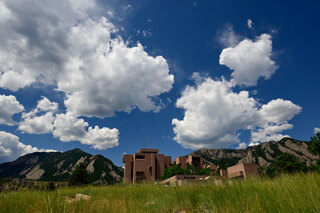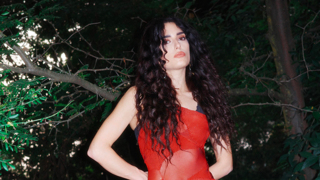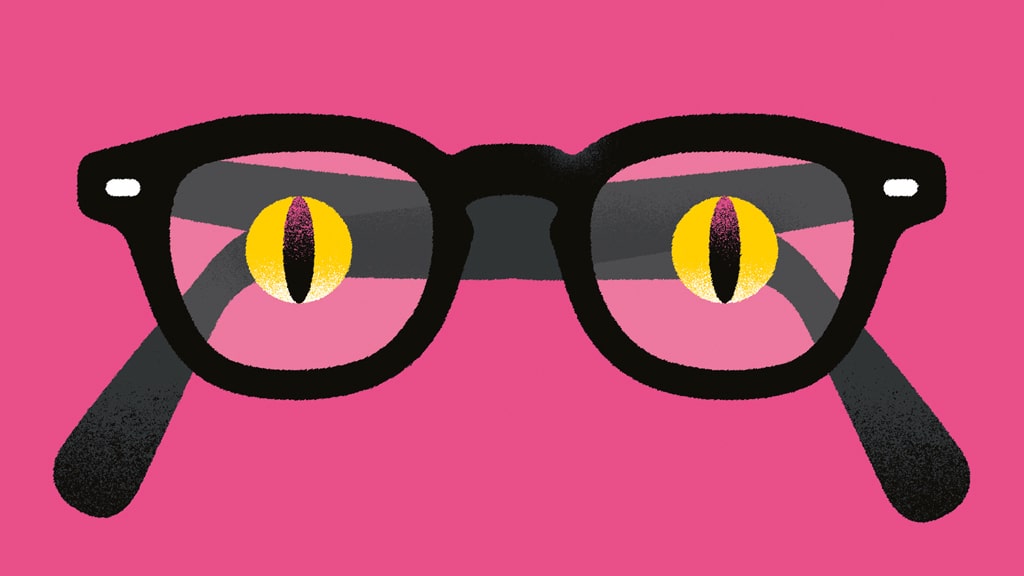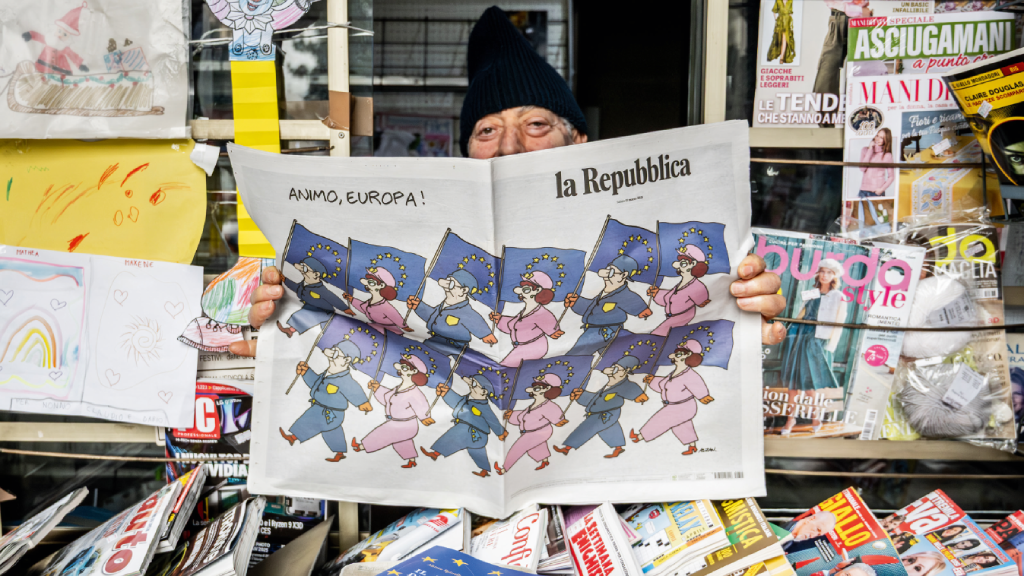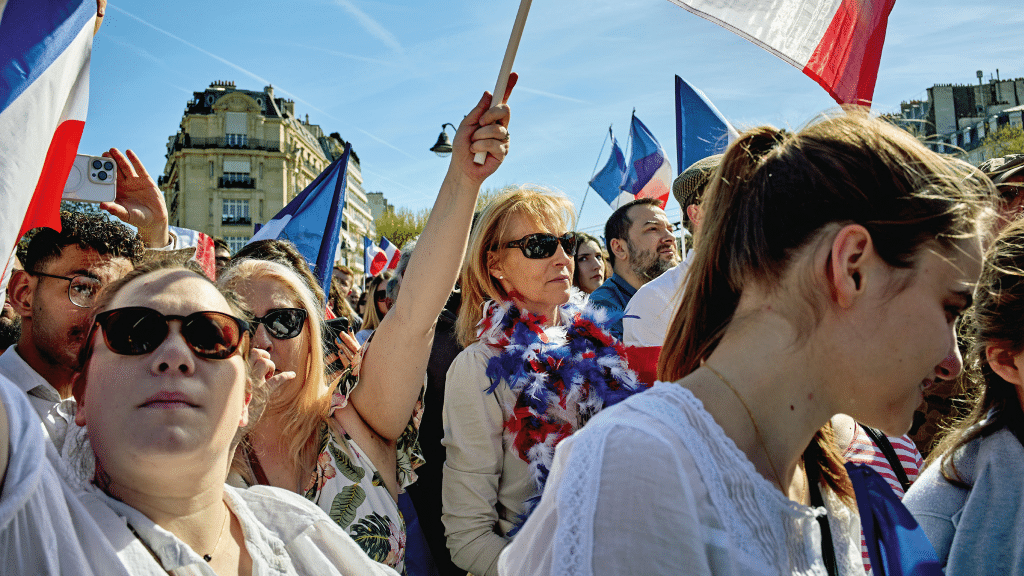Due sconosciute si incontrano in un giardino di Parigi. È l’inizio di un’amicizia speciale. Katharina è una giornalista belga che si è appena trasferita in cerca di lavoro, l’altra è una senzatetto che vive su un’isola della Senna. Le due non parlano la stessa lingua. Si incontrano, siedono su una panca e mangiano del cioccolato. Troveranno il modo di comunicare e di conoscersi “senza parole”.
Senza parole, di Katharina Smets
Belgio 2014, 18’20”
(leggi la traduzione in italiano dell’audiodocumentario)
Paris. A beautiful city. A city of many clichés and one cliché says you can feel a little bit overwhelmed by Paris. I feel it. I feel a little bit lost.
But you can easily hide here.
In the subway for example.
People avoid looking at each other in the subway.
I do my best to pretend I belong here and walk quickly along with the crowd.
There is a woman sitting on her knees in the middle of the metro hall and the crowd of people floats around her.
I get off on avenue President Kennedy. Random. I have no purpose.
I step on the bridge over the Seine.
The first thing I see is the Statue of Liberty. Strange.
In the middle of the Seine, there is an island.
The island starts somewhere near the Eiffel Tower, and there are boats with tourists over there.
I look down on the island. I see a plot of land with poppies, a wild meadow with overgrown grass and red flowers. A garden in the middle of Paris.
What strikes me is that the city benches under the bridge are arranged in a symmetrical manner.
I see that someone has painted the perfectly symmetrical benches with white round spots, in a perfectly symmetrical way.
On the middle bench, under the bridge, there is a neat little… house… made out of layers of plastic.
On a small footstool in the sun there is a woman quietly doing the laundry in a plastic bucket.
The bucket is also painted in white round spots.
She is sitting with her back towards the Statue of Liberty. And the Statue of Liberty, too, has her back turned to the woman with the hat. Wicker hat socks in sandals.
I notice that everything that belongs to her is painted with white spots.
I look around me. It’s quiet here. The sun is shining and the flowers wave in the warm wind. It’s like I’m on a farm in the countryside.
The woman washes quietly. I can not see her face because of the hat.
I want to speak to her but I don’t know how.
Silence.
What do you do all day when you’re homeless?
How do you become homeless?
Do you have a home somewhere else maybe? A home with a garden?
Do you like to be homeless? Is it a choice?
Where do you get your stuff?
Don’t you get scared at night?
We sit together.
It is quiet here. The woman wrings out her clothes and stands up. She walks toward the Seine.
A pair of red lacy panties falls out of her bucket.
I call her. She doesn’t react.
I jump right up and pick up the underwear.
The woman turns around and looks up from under the hat.
I’m startled. And try not to show it.
The skin of her face and her arms is peeling off. I try not to blink.
I don’t understand what she’s saying.
She walks to the Seine. One bucket with white spots is tied to a string and she throws that in the Seine. The other one is for rinsing out the clothes.
She returns to her little bench. We smile at each other. I want to ask her how it feels to live here.
She hangs the clothes on a drying rack in her little plastic tent. Calmly, she puts on her watch and slides rings onto her fingers that she had put aside on a little wooden table. The same gesture that my mom makes after doing the dishes.
From the corners of my eyes I see her rummaging in her tent. She comes towards me. I think she will ask me to go away. To stop recording. I better stop.
Rustle of cardboard and tinfoil.
I look up. She holds out a bar of chocolate. She breaks the chocolate in the pack so she wouldn’t touch it with her fingers. She has good manners. Where does the chocolate come from? She must have kept the chocolate in her tent for a special occasion. Am I a special occasion?
“Vay”.
“Take” she says. Or I think she says.
“Fiori” I say and point to the flowers. Are they hers?
“I manque di aqua” she says, I think they need water. I understand that.
She points at the peeling red skin in her face.
That is because of the water in the Seine she says. Or I guess she says.
I want to say something nice. That dark chocolate is the best kind of chocolate. Something I normally would say over the fence to my neighbor.
I try to make my words sound Italian. I try out every word I know.
I understand that.
“Without words”.
I want to tell her that I’ll return.
Tomorrow I’ll bring her something nice.
I want to give her a present only I can get her.
Something someone else wouldn’t think of.
A watering can. For the giardini.
To water the fiori.
The formal French garden is the classic image of order.
A French garden is open. Regular. With hedges, grass, gravel.
The regularity holds the unstructured nature outside.
The chaos.
In a French garden there is water.
And symmetry. Symmetry is very important.
Symmetry is what makes us human.
A French garden is constructed with angled lines that lead you to one point at the horizon. Or better: somewhere behind the horizon.
Flight lines, obviously, give you the dream of flight. An escape route.
And sometimes in the middle of such a line in the direction of infinity there is a statue.
The Statue of Liberty on an island.
I buy a watering can. And an iron rake and a hoe.
And then I wonder if I should have bought her something else with that money.
Drinking water, for example.
Or medication for skin disease.
Or maybe I’d better figure out where social services are.
I’m back to the Statue of Liberty and I feel foolish.
She’s not home.
But there is a lady sitting on one of the benches.
Do you know the lady who lives here?
Yes I know she has a problem with her skin.
Yes, she’s Italian.
I think she sleeps here.
Yes, she’s homeless.
There are a lot of homeless people living in Paris.
Even well educated people.
Next to this patisserie there is this engineer. First there was a divorce. He was inconsolable. Because he was inconsolable he didn’t go to work. Because he didn’t go to work he didn’t get a paycheck. And then he couldn’t pay the rent anymore. So things were going downhill. And downhill. He started to drink. All because of a divorce. It’s bad. Because the person you love the most in the world is not dead, but in the arms of someone else. You cannot mourn someone who is alive.
I learn that this is called the island of swans.
I leave the watering can on the island of swans where there are no swans anymore.
I leave a little note: “Buongiorno. Un cadeau par i fiori e il giardini. À la proxima. Katharina”.
I will come back tomorrow. And I will bring a list with questions in Italian. So I can finally talk to her about the things that matter.
I see her. I’ve written down a few phrases in Italian. What is your name? Where are you from?
Why did you come to Paris? Ultima fermata. The last stop. Paris is her last stop. Last stop for what? She’s Bulgarian.
She says she didn’t flee anything. I think. Something about passport. Something about green papers. That’s how it is. I’m not nostalgic. That’s what she says, I think. Go to the sea. I think she misses the sea. I want to understand her. I pretend to understand her.
But I understand she’s happy with the watering can. That it is charming.
Senza parole.
It is an Italian song she’s referring to.
It is a love song.
A love song about a couple that doesn’t understand each other anymore.
But that’s ok. Without words. Senza parole.
And I’ve looked inside your house. And I’ve understood that it was silly of me to think that you were only mine. And I’ve tried to forget. I’ve tried not to look.
But I’ve been walking for so long. And there was so much noise outside, that I stopped to think about all those things.
But before I go – we go up to see the statue of Libertà.
Leggi la traduzione in italiano dell’audiodocumentario:
Parigi. Una città bellissima. Una città sulla quale ci sono molti luoghi comuni, e uno di questi dice che ci si può sentire soffocati da Parigi. È così che mi sento. Mi sento un po’ persa.
Ma qui ci si può anche nascondere facilmente.
Nella metro, per esempio.
Nella metro le persone fanno di tutto per non guardarsi.
Faccio finta di sembrare a mio agio, e cammino in fretta mescolandomi alle persone.
C’è una signora inginocchiata nel mezzo della stazione e la folla delle persone le scorre accanto.
Scendo ad Avenue President Kennedy.
A caso. Senza meta.
Cammino su un ponte che attraversa la Senna.
La prima cosa che vedo è la Statua della Libertà. Strano.
In mezzo alla Senna, c’è un’isola.
L’isola inizia in un punto vicino alla torre Eiffel, e ci sono dei battelli con i turisti.
Dal ponte guardo l’isola.
Vedo un campo di papaveri, un prato abbandonato con l’erba alta e dei fiori rossi
Un giardino, nel bel mezzo di Parigi.
Quello che mi colpisce sono le panchine, che sono sistemate sotto il ponte in ordine simmetrico.
Qualcuno ha dipinto queste panchine perfettamente simmetriche con dei cerchi bianchi, anch’essi in un ordine perfettamente simmetrico.
Sulla panchina centrale, sotto il ponte, c’è una… casetta carina… fatta di pannelli di plastica.
Appoggiata su un piccolo poggiapiedi sotto il sole c’è una signora che fa il bucato in una bacinella di plastica.
Anche la bacinella è dipinta con cerchi bianchi.
È seduta con la schiena rivolta alla Statua della Libertà.
E anche la Statua della Libertà dà la schiena alla signora col cappello.
Un cappello di paglia.
Calzini nei sandali.
Mi accorgo che tutte le sue cose sono dipinte con cerchi bianchi.
Mi guardo intorno.
È tranquillo qui.
Splende il sole e l’onda di fiori si muove in un vento tiepido.
Mi sembra di essere in una fattoria in campagna.
La signora fa il bucato tranquilla.
Non riesco a vederle il viso per colpa del cappello.
Vorrei parlare con lei ma non so come fare.
Silenzio.
Che cosa si fa tutto il giorno quando si è senzatetto?
Come si diventa senzatetto?
Hai una casa magari da qualche parte? Una casa col giardino?
Ti piace vivere così? È una cosa che hai scelto?
Dove prendi tutte le tue cose?
Non hai paura di notte?
Ci sediamo vicine.
È tranquillo qui.
La signora strizza i vestiti e si alza.
Cammina lungo la Senna.
Un paio di mutande rosse di pizzo cadono dalla bacinella.
La chiamo.
Non risponde.
Mi alzo e raccolgo le mutande.
La signora si gira e guarda da sotto il cappello.
Mi agito un po’. E cerco di non farlo vedere.
La pelle sul viso e sulle braccia è tutta rovinata.
Cerco di non reagire.
Non capisco cosa mi sta dicendo.
Torna verso la Senna.
Una bacinella con i cerchi bianchi è legata con una corda e la lancia nella Senna.
L’altra è per sciacquare i panni.
Ritorna alla sua piccola panchina. Ci sorridiamo.
Vorrei chiederle com’è vivere lì.
Appende i vestiti su uno stendibiancheria nella sua piccola tenda di plastica.
Lentamente, indossa l’orologio e infila nelle dita gli anelli che aveva messo da parte su un tavolino di legno
Lo stesso gesto che fa mia madre dopo aver lavato i piatti.
Con la coda dell’occhio la vedo rovistare nella sua tenda.
Viene verso di me.
Mi chiederà di andarmene.
Spengo il registratore.
È meglio che mi fermi.
Fruscio di cartoncino e carta stagnola.
Alzo lo sguardo.
Tira fuori una barretta di cioccolato.
Rompe la barretta nella stagnola in modo da non toccarla con le dita.
È molto educata.
Da dove verrà il cioccolato?
Deve averlo conservato per una occasione speciale.
Sono io quell’occasione speciale?
“Vai!”.
“Prendi”, mi dice. O così ho capito io.
“Fiori”, dico io, e indico i fiori.
Sono suoi?
“Manca di acqua”, dice. Mi sa che hanno bisogno d’acqua.
O almeno così ho capito.
Mi indica la pelle rossa irritata sul suo viso.
Mi dice che è per colpa dell’acqua nella Senna.
O almeno credo.
Vorrei dirle qualcosa di carino.
Il cioccolato fondente è il migliore.
Qualcosa che direi ai miei vicini di casa.
Cerco di dare alle mie parole un suono italiano.
Provo con tutte le parole che conosco.
Questo lo capisco.
Senza Parole.
Vorrei dirle che tornerò.
Domani le porterò qualcosa di carino.
Voglio prenderle qualcosa che solo io posso prenderle.
Qualcosa a cui nessun altro penserebbe.
Un annaffiatoio. Per i giardini.
Per dare acqua ai fiori.
I giardini francesi sono il classico esempio di ordine.
Un giardino francese è aperto. Regolare. Con siepi, erba, ghiaino.
L’ordine chiude fuori il disordine della natura.
Il caos.
In un giardino francese c’è acqua.
E la simmetria, la simmetria è davvero fondamentale.
La simmetria è ciò che ci rende esseri umani.
Un giardino francese è costruito con linee geometriche che orientano il tuo sguardo verso un punto all’orizzonte.
Anzi: in un punto dietro all’orizzonte.
Traiettorie di volo che, ovviamente, ti danno l’illusione di volare. Una via di fuga.
E a volte in mezzo a quell’intreccio di linee in direzione dell’infinito c’è una statua.
La Statua della Libertà su un’isola.
Compro un annaffiatoio. E un rastrello e una zappa.
E poi mi chiedo se avrei dovuto comprare qualcos’altro con quei soldi.
Bottiglie d’acqua, per esempio.
O una pomata per la pelle rovinata.
O magari sarebbe stato meglio capire che fine hanno fatto i servizi sociali.
Sono di nuovo alla Statua della Libertà e mi sento stupida.
Non è a casa.
Ma c’è una signora seduta su una panchina.
Conosce la signora che vive qui?
Sì, lo so ha delle irritazioni alla pelle.
Si, è italiana.
Penso che dorma qui.
Si, è senzatetto.
Ci sono moltissimi senzatetto a Parigi.
Anche persone di buona famiglia.
Vicino a questa pasticceria c’è un ingegnere.
Prima c’è stato un divorzio. Era molto triste. Siccome era triste ha smesso di andare a lavorare. Siccome ha smesso di andare a lavorare non aveva più uno stipendio. Non poteva più pagarsi l’affitto.
Tutto ha cominciato ad andare a rotoli. E a rotoli. Ha iniziato a bere. E tutto per un divorzio.
Un divorzio è una brutta cosa. Anche perché la persona che ami di più al mondo non è morta, ma tra le braccia di qualcun altro. Non puoi piangere qualcuno che è ancora vivo.
Scopro che questa si chiama l’isola dei cigni.
Lascio l’annaffiatoio su quest’isola dei cigni dove i cigni non ci sono più.
Lascio un biglietto.
Tornerò domani.
E mi porterò una lista di domande in italiano.
Così potremmo finalmente parlare di cose importanti.
La vedo.
Ho scritto qualche frase in italiano.
Come si chiama?
Da dove viene?
Come mai è arrivata a Parigi?
L’ultima fermata. Parigi è l’ultima fermata.
L’ultima fermata per cosa?
È bulgara.
Dice che non è scappata, credo.
Qualcosa sui passaporti, qualcosa sui permessi di soggiorno.
È andata così.
“Non sono nostalgica”, mi dice, credo.
Va al mare.
Penso le manchi il mare.
Voglio capire quello che dice, faccio finta di capire.
Ma capisco che è contenta dell’annaffiatoio. Che è carino.
Senza parole. Sta parlando di una canzone italiana.
È una canzone d’amore.
Una canzone d’amore che parla di una coppia che non riesce più a capirsi.
Ma va bene così.
Senza parole.
E ho guardato dentro casa tua. E ho capito che era una follia avere pensato che fossi soltanto mia. E ho cercato di dimenticare. Di non guardare.
Ma poi ho camminato tanto e fuori c’era un gran rumore, che non ho più pensato a tutte queste cose.
Ma prima di andarmene, saliamo a vedere la Statua della Libertà.
La sezione audiocumentari è a cura di Jonathan Zenti di Audiodoc.
Internazionale pubblica ogni settimana una pagina di lettere. Ci piacerebbe sapere cosa pensi di questo articolo. Scrivici a: posta@internazionale.it

